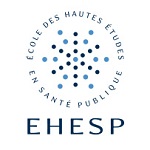Oxydation du diuron et identification de quelques sous-produits de la réaction
Abstract
During drinking-water production, pesticides can be modified under the action of powerful oxidizing agents such as ozone. However, the mineralization process is rarely complete and it is therefore important to know both the nature and the concentration of intermediate by-products. The main goal of this work was to identify the Diuron oxidation reaction by-products in order to explain the reaction mechanisms and determine the efficiency factors of proposed treatments to destroy these substances in drinking-water. Trials were carried out in a continuous "bubbling column" reactor type operating in an up-flow mode. This Pyrex reactor was one meter high with a one liter volume. The Diuron concentration in test solutions was fixed at either 0.01 mg L -1 , which is the maximum value found in natural water, and 5 mg L -1 to facilitate the identification of the reaction by-products. Test solutions were prepared from a standard solution by dilution into ultrapure water (Total Organic Carbon=TOC < 0.1 mg L -1 ) buffered with phosphate at pH=7. The following experimental conditions were used for the 0.01 mg L -1 and 5 mg L -1 test solutions, respectively: O 3 dose=2 and 6 mg L -1 ; H 2 O 2 /O 3 molar ratio=0.35; contact times=8 and 30 min. Hypotheses on the nature of the Diuron oxidation reaction by-products were based on previous experiments carried out on Isoproturon and Metoxuron (Allemane 1994; Mansour 1992). To identify the reaction products, we performed a liquid phase-solid phase extraction on C 18 -grafted silica cartridges. Diuron byproducts were identified by gas chromatography-mass spectrometer (GC-MS), after a derivatization reaction with butyl-iodide. Results show that during the oxidation reaction the aromatic cycle is preserved in three by-products: N-(3,4 dichlorophenyl)-N-(methyl)-urea (DCPMU), N-(3,4 dichlorophenyl)-urea (DCPU) and 3,4 dichloroaniline (DCA). These compounds were found in Diuron solutions treated with ozone or with the ozone-hydrogen peroxide couple. They were identified by comparing their chromatograms with those of the pure isolated substances (retention times and mass spectra). Products were quantified by High Performance Liquid Chromatography (HPLC). The Diuron transformation percentages were found to be 80% with ozone and 90% with the O 3 /H 2 O 2 couple under extreme experimental conditions i.e. C o =5 mg L -1 , [O 3 ]=6 mg L -1 and a 30 minutes reaction time. The TOC measurements show that under these conditions the Diuron mineralization process reaches 50%. A mass balance showed that DCPMU was one of the main oxidation reaction residual by-products with amounts corresponding to 5-7% of the initial quantity of Diuron.
Ce travail étudie la dégradation en milieu aqueux de l'herbicide diuron (N-(3,4 dichlorophényl)-N'-(diméthyl)-urée) par oxydation radicalaire. Des solutions de diuron (0,01 mg L -1 et 5 mg L -1 ) tamponnées à pH=7 ont été traitées par l'ozone et par le couple peroxyde d'hydrogène-ozone (0,35 mole/mole). Les doses d´ozone appliquées ont été de 2 mg O 3 L -1 pour la solution de diuron à 0,01 mg L -1 et 6 mg O 3 L -1 pour la solution à 5 mg L -1 . Les temps de réaction utilisés ont été de 30 min pour la forte concentration en diuron et de 8 min pour la concentration faible. L'identification de quelques sous-produits par chromatographie gazeuse couplée à la spectrométrie de masse (CG-SM) a été réalisée sur les extraits des solutions traitées. Les résultats montrent que lors de l'oxydation, le cycle aromatique est conservé pour trois sous-produits : la N-(3,4 dichlorophényl)-N-(méthyl)-urée (DCPMU), la N-(3,4 dichlorophényl)-N-(méthyl)-urée (DCPU) et la 3,4 dichloroaniline (DCA). Ces composés ont été identifiés à la fois dans les solutions de diuron traitées par l'ozone et dans celles traitées par le couple ozone-peroxyde d'hydrogène. La quantification du diuron et des sous-produits identifiés a été faite par chromatographie liquide à haute performance (HPLC). Le pourcentage d'oxydation du diuron par l'ozone et le couple ozone-peroxyde d'hydrogène est élevé (respectivement 80% et 90%), pour les conditions expérimentales : C o =5 mg L -1 ; temps de réaction=30 min et ozone appliqué=6 mg L -1 . Le dosage du carbone organique total (COT) a mis en évidence une minéralisation partielle de cet herbicide (" 50%). Le bilan massique de la réaction montre que le DCPMU est un des principaux sous-produits d'oxydation du diuron (de 5 à 7% de la quantité initiale de diuron).
